|
Bonnier (Gaston) & Layens (G.De)
Flore complète portative de la Suisse et de la Belgique pour trouver facilement les noms des plantes sans mots techniques.
Paris ibrairie générale de l'enseignement. 1970 425p 1 volume In8 broché.Ouvrage orné de 5338 figures et d'une carte des régions de la France et une carte des régions de la Suisse.
Referencia librero : 180020
|
|
|
Bonnier, G. & G. de Layens
Flore Complète Portative de la France, de la Suisse et de la Belgique, Pour trouver facilement les Noms des plantes sans mots techniques.
1968 (new ed.) xxvii, 425, [1] p., 5338 figs, 1 map, hardbound (original printed front cover laid on, plastified).
Referencia librero : BF15510
|
|
|
Bonnier, G. & G. de Layens
Flore Complète Portative de la France, de la Suisse et de la Belgique, Pour trouver facilement les Noms des plantes sans mots techniques.
1975 (new ed.) xxvii, 425, [1] p., 5338 figs, 1 map, paperbound.
Referencia librero : BF15598
|
|
|
Bonnier (Gaston) / De Layens (G.).
FLORE COMPLETE PORTATIVE DE LA FRANCE, DE LA SUISSE ET DE LA BELGIQUE.
P., Librairie Générale de l'Enseignement, 1977. In-8 broché, XXVII-425 pages, 5338 figures in-txt.
Referencia librero : 5332
|
|
|
BONNIER, Gaston:
Flore complète illustré en couleurs de France, Suisse et Belgique (Comprenant la plupart des plantes d'Europe). Tome 3 (seul).
Neuchâtel, Delachaux et Niestlé, Paris et Bruxelles, s.d. (1912-1934), gr. in-4°, 122 p. + 60 planches couleur / 136 p. + pl. 61 à 120 (sur 721 planches couleur) livraisons non reliés orig. dans un cartable vert a lanières de l'éditeur
Referencia librero : 63540aaf
|
|
|
BONNIER gaston - DE LAYENS Georges
Flore complète portative de la France, de la Suisse et de la Belgique pour trouver facilement les noms des plantes sans mots techniques
Belin Belin, 1986. In-8 relié cartonnage souple éditeur, 426 pages. 5338 figures. Bon état
Referencia librero : 183150

|
|
|
BONNIER, Gaston
Flore complète illustrée en couleurs de France, Suisse et Belgique (Tome Premier complet en 10 fascicules)
10 fascicules in-4 br., Librairie Générale de l'Enseignement, L. Orlhac, Paris, s.d. [ circa 1920 ], 120 pp. et 60 planches volantes en couleurs
Referencia librero : 62509

|
|
|
BONNIER Gaston et LAYENS Geoges De.
Flore de la France.
Tableaux synoptiques des plantes vasculaires de la flore de la France. P. Paul Dupont, Sans date (vers 1920). In-8, XXVII-412 pages. Cartonnage éditeur gris.
Referencia librero : 14457
|
|
|
BONNIER, Gaston - LAYENS, G. de.
Flore complète de la France et de la Suisse (comprenant aussi toutes les espèces de Belgique) pour trouver facilement les noms des plantes sans mots technique. 5338 figures représentant les caractères de toutes les espèces avec une carte des régions de France et une carte des régions de Suisse. 5e édition revue et corrigée.
Neuchâtel, Delachaux & Niestlé sans date, 225x140mm, XXVII- 425pages, reliure d'éditeur.
Referencia librero : 34561
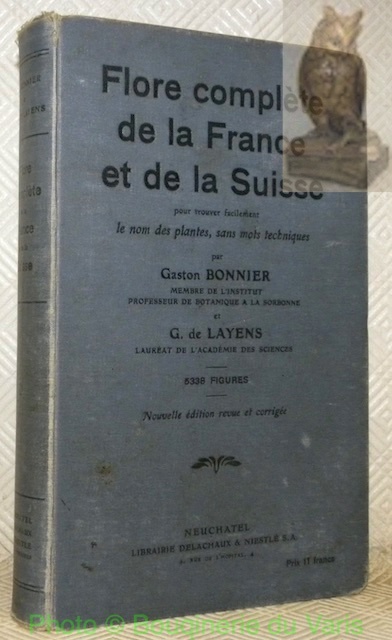
|
|
|
Bonnier Layens
Flore complète portative de la France de la Suisse et de la Belgique pour trouver facilement les noms des plantes sans mots techniques
Librairie générale de l'enseignement 1966 in8. 1966. broché. illustré en noir et blanc
Referencia librero : 100052295

|
|
|
Bonnier Layens
Flore complète portative de la France de la Suisse et de la Belgique pour trouver facilement les noms des plantes sans mots techniques
librairie générale de l'enseignement 1970 in8. 1970. Broché.
Referencia librero : 100115681

|
|
|
Bonnier Layens G. D Layens
Flore complète portative de la France de la Suisse et de la Belgique pour trouver facilement les noms des plantes sans mots techniques
librairie générale de l'enseignement 1974 in8. 1974. Broché.
Referencia librero : 100128970

|
|
|
Bonnier Layens G. de
Flore complète portative de la France et de la Suisse. Comprenant aussi toutes les espèces de Belgique d'Alsace et de Lorraine. Pour trouver facilement les noms des plantes sans mots techniques. 5338
librairie générale de l'enseignement in8. Sans date. Broché. Flore complète portative de la France et de la Suisse. Comprenant aussi toutes les espèces de Belgique d'Alsace et de Lorraine. Pour trouver facilement les noms des plantes sans mots techniques. 5338 figures représentant les caractères de toutes les espèces avec une carte des régions de la France et une carte des régions de la Suisse. Nouvelle édition revue et corrigée. BONNIER Gaston. - LAYENS G. de
Referencia librero : 100129282

|
|
|
Bonnier Gaston G. De Layens
Flore complète portative de la France de la Suisse et de la Belgique --- 5338 figues
librairie générale de l'enseignement 1964 in8. 1964. Broché.
Referencia librero : 100132201

|
|
|
BONNIER Gaston
Gaston Bonnier, membre de l'institut. Extrait de l'album Mariani. Figures contemporaines, onzième volume. Notice biographique de deux pages par Octave Uzanne. Un portrait gravé sur bois et un fac-similé d'autographe vantant les mérites du vin de coca Mariani.
- Trois pages 19 x 27 cm.
Referencia librero : 86386
|
|
|
Bontemps Michel
Herbier sylvicole naturel - Chêne pédonculé - chêne vert - chêne liège - chêne d'amérique - ormeau champetre - chêne des marais - peuplier tremble - pin maritime - pin sylvestre - séquoia géant - robinier faux acacia etc.
chez l'auteur. non daté. In-4. Broché. Bon état, Couv. convenable, Dos satisfaisant, Intérieur frais. Herbier sylvicole naturel d'environ 30 pages - 2 photos disponibles.. . . . Classification Dewey : 580-Botanique
Referencia librero : R320124116

|
|
|
Bontemps / ALVES / CARNEC / HAYE / NOUET....
Herbier de plantes parasites - Gui blanc - custute - claque du pêcher - oïdium de chêne - charbon nus des céréales - rouilles - tavelure - chabon couvert de l'avoine - chancre - fumagine - orobanche.
non précisé. non daté. In-4. Broché. Bon état, Couv. convenable, Dos satisfaisant, Intérieur frais. Herbier naturel de plantes parasites contenant 12 pages dont 2 pages vierges - 2 photos disponibles.. . . . Classification Dewey : 580-Botanique
Referencia librero : R320123807

|
|
|
Bontemps Michel
Herbier naturel - Ajonc - bruyère cendrée - petite oseille - genêt à balai - spergule des champs - chicorée sauvage - joncs étalé - moutarde des champs - mourron blanc etc.
non précisé. non daté. In-4. En feuillets. Bon état, Couv. convenable, Dos satisfaisant, Intérieur frais. Herbier naturel de 24 pages (quelques plantes absentes sur quelques pages).. . . . Classification Dewey : 580-Botanique
Referencia librero : R320123836

|
|
|
Bontemps Michel
Herbier des prairies - Herbier naturel.
chez l'auteur. non daté. In-8. Broché. Bon état, Couv. convenable, Dos satisfaisant, Intérieur frais. Herbire naturel des prairies contenant environ 40 pages.. . . . Classification Dewey : 580-Botanique
Referencia librero : R320124020

|
|
|
BONNIER Gaston
Histoire naturelle. Première année : Zoologie et botanique.
Couverture rigide. Reliure toile de l'éditeur, défraîchie. 461 pages. Légèrement défraîchi.
Referencia librero : 62883

|
|
|
BONAFOUS, Matthieu.
Histoire naturelle, agricole et économique du Maïs.
Paris, Huzard, 1836. In-folio – 37x55cm. Reliure d’époque en demi-cartonnage saumon, dos lisse orné de filets dorés. Première édition, illustrée de 20 planches gravées, dont 15 imprimées en couleurs et retouchées à la main, et de 11 illustrations dans le texte, dont le portrait d'Henri-Alexandre Tessier, dédicataire de l'ouvrage. La planche V bis est gravée d’après la dernière peinture de botanique réalisée par Pierre-Joseph Redouté (1759-1840).Rare ouvrage.L'agronome Matthieu Bonafous étudia les cultures répandues dans le midi de la France : vigne, riz, soie, et maïs. Son Histoire naturelle du maïs évoque l'origine de la plante, en décrit les différentes variétés, traite de la culture, de la récolte, de l'égrenage, des nuisibles, et de leur impact sur l'économie rurale. Les illustrations mettent en valeur la diversité du maïs, les machines à égrener et les maladies dues aux insectes ou à des champignons. [Pritzel, 966. Nissen, 198. Great Flower Books, 51].
Referencia librero : 1695
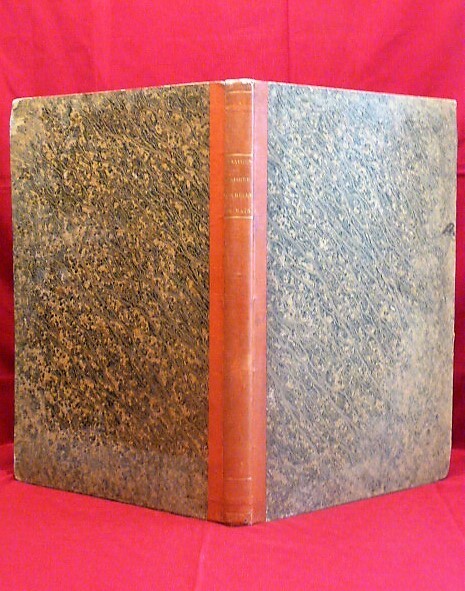
|
|
|
Bonnet Charles
L'amour végétal ou les noces des plantes - Edition augmentée des lettres de Jean-Jacques Rousseau sur la botanique et imagée par Henri-Jacques Darrort.
Louis Pariente. 1978. In-4. Relié. Bon état, Couv. convenable, Dos satisfaisant, Intérieur frais. 172 pages - quelques dessins en noir et blanc dans et hors texte - sous emboitage cartonné rigide marron en bon état.. . . . Classification Dewey : 580-Botanique
Referencia librero : R320138721
|
|
|
BONNET Charles
L'amour végétal
Louis Pariente Editions Louis Pariente, 1978. In-4 relié toile éditeur nouée par lacets de 172 pages. Editions augmentées des lettres de Jean-Jacques Rousseau sur la botanique et imagée par Henri-Jacques Darrot. Tirage limité numéroté. Bon exemplaire
Referencia librero : 184108
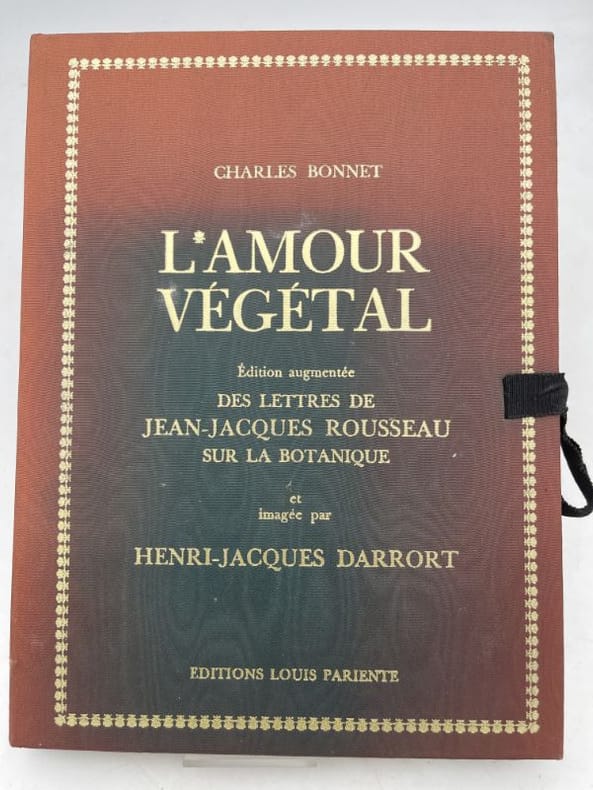
|
|
|
Bonnet Charles
L'Amour végétal, édition augmentée des lettres de Jean-Jacques Rousseau sur la botanique
Editions Louis Pariente Cartonné 1978 In-4 (21 x 28 cm), cartonné toilé, 172 pages ; dos, bords des plats et bords des contreplats insolés, par ailleurs assez bon état général. Livraison a domicile (La Poste) ou en Mondial Relay sur simple demande.
Referencia librero : xf237
|
|
|
BONNET (Charles) - [DARRORT (Henri-Jacques)].-
L'Amour végétal, ou les Noces des plantes ; édition corrigée et augmentée des Lettres de J.-J. Rousseau sur la Botanique. Avec trente dessins originaux d'Henri-Jacques DARRORT.
P., Editions Louis Pariente, 1978, in 4° broché, emboité dans un portefeuille de soie verte de l'éditeur, avec lacets, 172 pages ; dos du portefeuille insolé, menus défauts d'usage sur les plats.
Referencia librero : 52154
|
|
|
BONHEUR GASTON
L'HERBIER DES PYRENEES
LAFFONT. 1974. In-4. En feuillets. Bon état, Couv. convenable, Dos satisfaisant, Intérieur frais. 15 pages plus plusieurs dizaines de planches à herbier naturel à compléter (quelques planches le sont déjà). Avec serpentes.. . . . Classification Dewey : 580-Botanique
Referencia librero : R300001354
|
|
|
BONNIER GASTON
LA METHODE SIMPLE POUR TROUVER LES NOMS DES FLEURS SANS AUCUNE NOTION DE BOTANIQUE
LIBRAIRIE GENERALE DE L'ENSEIGNEMENT. 1911. In-12. Relié. Bon état, Couv. convenable, Dos satisfaisant, Intérieur frais. 340 pages illustrées de nombreuses gravures dans le texte.. . . . Classification Dewey : 580-Botanique
Referencia librero : R300000207

|
|
|
BONNIER Gaston & De LAYENS Georges
La Végétation de la France, Suisse et Belgique. 1re partie. FLORE OMPLETE PORTATIVE DE LA FRANCE, de la SUISSE et de la Belgique
Paris Librairie Générale de l'Enseignement. E. Orlhac, Editeur 1974 in 8 (22,5x14) 1 volume reliure demi chagrin havane à coins, dos à nerfs, couverture conservée, XXVII et 425 pages, 5338 figures. Nouvelle édition revue et corrigée. Gaston Bonnier, Paris 1853-1922, botaniste français, membre de l'institut, Professeur de Botanique à la Sorbonne. G. de Layens, Lauréat de l'Académie des Sciences. Bon exemplaire ( Photographies sur demande / We can send pictures of this book on simple request )
Referencia librero : 45062
|
|
|
BONNIER (Gaston)
La vie et la carrière scientifique de P. Duchartre.
Paris, Revue Générale de Botanique, 1894. plaquette in-8, 24 pages. Brochée.
Referencia librero : 33798
|
|
|
BONNIER DANIEL
LE GUIDE DU JARDINAGE FACILE - JUIN 98 : 40 REGLES DE BASE POUR BIEN JARDINIER / 40 PLANTES FACILES A REUSSIR / OU APPRENDRE A JARDINER / L'EQUIPEMENT INDISPENSABLE DU JARDINIER.
PUBLICATIONS BONNIER. 1998. In-4. Broché. Bon état, Couv. convenable, Dos satisfaisant, Intérieur frais. 33 pages. Nombreuses photos en couleurs dans et hors texte.. . . . Classification Dewey : 580-Botanique
Referencia librero : R200031654
|
|
|
BONNIER GASTON
LE MONDE VEGETAL- BIBLIOTHEQUE DE PHILOSOPHIE SCIENTIFIQUE
FLAMMARION. 1909. In-8. Broché. Bon état, Couv. convenable, Dos satisfaisant, Intérieur frais. 390 + 8 pages d'extrait de catalogue de la collection de l'éditeur- quelques figures en noir et blanc dans le texte. . . . Classification Dewey : 580-Botanique
Referencia librero : R150219804
|
|
|
Bonnier Gaston, De Layens G.
Le végétation de la France, Suisse et Belgique 1ère partie: Flore complète portative de la France et de la Suisse
Librairie générale de l'enseignement. Non daté. In-8. Cartonné. Etat passable, Couv. convenable, Coiffe en tête abîmée, Intérieur frais. 425 pages. 5338 figures en N&B, dans le texte. Gouttière tâchée. Nombruses documents ajoutés. 1er plat partiellement désoldarisé.. . . . Classification Dewey : 580-Botanique
Referencia librero : RO30321191

|
|
|
Bonelle, C.
Le jardinier d'Artois, ou les élémens de la culture des jardins potagers et fruitiers.
1766 x, 288, viii p., engraved vignette on title and head and tail-pieces, full-page and half-page coats-of-arms, contemporary full calf (spine gilt, with ornemantal urns stamped on the compartments). First free endpaper missing. Previous owners name written on half-title and title-page in old hand.Rare gardening manual specifically devoted to cultivation in northern France. The author offers here the results of his life's experience as a gardener. He deals with local methods of cultivation and layout, and describes suitable plants and fruits; these include absinth, asparagus, mustard, horse-radish, lamb's lettuce, herbs, apricots, grapes, plums, cherries and gooseberries. Separate treatises are devoted to oranges, pinks and carnations.
Referencia librero : BG04119
|
|
|
Bonheure (Denis)
Le Théier
Maisonneuve et Larose, n° 10 1989 Format poche In-12 broché. 159 pages. Bon état d’occasion.
Referencia librero : 34581
|
|
|
BONNIER (Gaston).-
Le Monde végétal. 230 figures dans le texte.
P., Flammarion (Bibliothèque de Philosophie Scientifique), 1910, in 12 broché, 392 pages ; en partie non coupé ; couverture fanée.
Referencia librero : 23200
|
|
|
BONNIER Gaston
Les noms des fleurs
Librairie générale de l'enseignement. Non daté. In-12. Cartonné. Etat du neuf, Coins frottés, Dos frotté, Quelques rousseurs. 340 Pages.372 photographies en couleurs et 2715 figures en noir par B HERINCQ et J POINSOT. -. . . . Classification Dewey : 580-Botanique
Referencia librero : ROD0009626
|
|
|
BONNIER Gaston
Les noms des fleurs, trouvés par la méthode simple sans aucune notions de botannique.
LIBRAIRIE GENERALE DE L'ENSEIGNEMENT. Non daté. In-12. Relié toilé. Etat d'usage, Couv. défraîchie, Coiffe en tête abîmée, Quelques rousseurs. 340 pages. Nombreuses illustrations en noir et blanc dans le texte. Nombreuses planches d'illustrations en couleurs, hors-texte. Dos abîmé. Dos toilé bleu.. . . . Classification Dewey : 580-Botanique
Referencia librero : RO20038753
|
|
|
BONIER GASTON
LES PLANTES DES CHAMPS ET DES BOIS - EXCURSIONS BOTANIQUES : PRINTEMPS - ETE - AUTOMNE - HIVER
J.-B. BAILLIERE ET FILS. NON DATE. In-8. Broché. Etat d'usage, Couv. défraîchie, Dos abîmé, Rousseurs. 568 pages. Nombreuses illustrations en noir et blanc,dans et hors texte. Traces de rouilles en reliure interieur.. . . . Classification Dewey : 580-Botanique
Referencia librero : R200092979
|
|
|
BONNIER (Gaston)
Les plantes des champs et des bois. Excursions botaniques. Printemps - Eté - Automne - Hiver.
Paris Baillières et Fils, 1887. Pt. in-4°, VII-568p. Reliure demi-basane marron.
Referencia librero : 42367
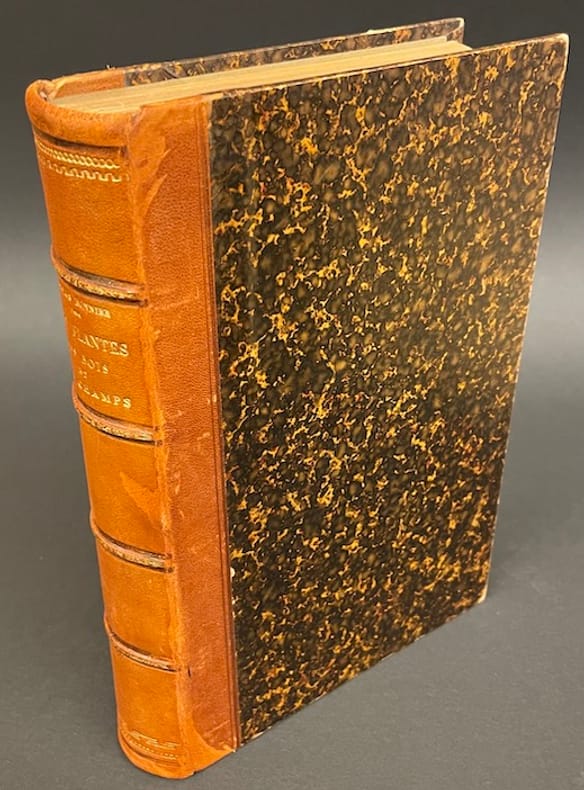
|
|
|
Bonnier (Gaston)
Les Plantes des champs et des bois, excursions botaniques printemps, été, automne, hiver.
J.-B. Baillière, sd 1900 In-4 demi-chagrin rouge, dos à nerfs, filets à froid, roulettes, fleurons, 568 pp. Index. 873 figures dans le texte, 30 planches hors-texte dont 8 en couleurs dessinées d'après nature par E. Mesplès. Dos frotté, coupes un peu usés. Quelques rousseurs.
Referencia librero : 15986

|
|
|
BONNIER (Gaston)
Les plantes des champs et des bois.
Paris, J.-B. Baillière et Fils, s.d. [1902] Fort in-4, rel. demi-maroquin rouge, dos lisse orné d'un décor doré en long, titre doré, tête dorée, 568 pp., 873 fig. in-t., 22 planches en n/b., 8 planches en chromolithographie sous serpente, tables alphabétique des noms français des familles et des espèces étudiées, des noms botaniques latins des espèces étudiées, table des planches h.-t., table méthodique des matières.
Referencia librero : 601480

|
|
|
BONIFAS-GUIZOT (Mme).
Leçons de botanique à l'usage des jeunes gens des deux sexes ou instructions sur le règne végétal présentées à l'esprit et au coeur.
Grenoble, Prudhomme, 1837, 1 veau raciné, plats et dos frottés. in-8 de de XII-348 pp. + 4 planches dépliantes, envoi autographe, signé de l'auteur, légères rousseurs ;
Referencia librero : 4373
|
|
|
BONNIER Gaston et DE LAYENS Georges.
Nouvelle Flore, pour la détermination facile des plantes, sans mots techniques.
LIBRAIRIE GENERALE DE L'ENSEIGNEMENT. 14ème édition. 1923. In-12. Cartonné. Etat d'usage, Couv. défraîchie, Dos satisfaisant, Intérieur frais. 285 pages. Nombreux dessins en noir et blanc dans le texte. Ouvrage déboité. Dos consolidé avec de la bande adhésive bleue. Quelques pages volantes. Coins et tranches des plats frottés. Quelques tampons de librairie.. . . . Classification Dewey : 580-Botanique
Referencia librero : RO80032041
|
|
|
BONNIER Gaston - DE LAYENS Georges.
Nouvelle Flore.
LIBRAIRIE GENERALE DE L'ENSEIGNEMENT. 14ème édition. 1934. In-12. Broché. Bon état, Couv. légèrement passée, Dos satisfaisant, Intérieur acceptable. 285 pages. Nombreuses illustrations en noir et blanc, dans le texte.. . . . Classification Dewey : 580-Botanique
Referencia librero : RO80049858

|
|
|
BONNIER G. et DE LAYENS G.
Nouvelle Flore pour la détrmination facile des plantes, sans mots techniques.
DUPONT Paul. 6ème édition. 1897. In-12. Cartonnage d'éditeurs. Etat d'usage, Couv. légèrement passée, Dos satisfaisant, Intérieur acceptable. 280 pages. Nombreuses figures en noir et blanc, dans le texte. Tranches rouges.. . . . Classification Dewey : 580-Botanique
Referencia librero : RO80061059

|
|
|
BONNIER GASTON
NOUVELLE FLORE
LIBRAIRIE GENERALE DE L'ENSEIGNEMENT. 1946. In-8. Broché. Bon état, Couv. convenable, Coiffe en pied abîmée, Intérieur frais. 285 pages. Nombreux dessins en noir et blanc dans et hors texte. Ecritures sur le premier plat. Second plat détaché.. . . . Classification Dewey : 580-Botanique
Referencia librero : RO30026397
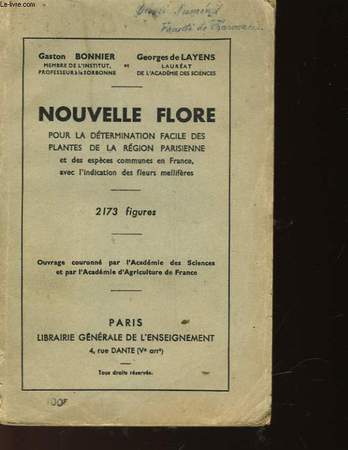
|
|
|
BONNIER GASTON
NOUVELLES FLORE POUR LA DETERMINATION FACILE DES PLANTES
LIBRAIRIE GENERALE DE L'ENSEIGNEMENT - 14° EDITION. non daté. In-12. Broché. Bon état, Couv. convenable, Dos satisfaisant, Intérieur frais. 285 pages. Nombreux dessins en noir et blanc dans le texte.. . . . Classification Dewey : 580-Botanique
Referencia librero : RO30047810

|
|
|
BONNIER Gaston / DE LAYENS Georges
Nouvelle flore pour la détermination facile des plantes sans mots techniques.
LIBRAIRIE GENERALE DE L'ENSEIGNEMENT. 1936. In-12. Relié toilé. Bon état, Couv. légèrement passée, Dos satisfaisant, Intérieur bon état. 285 pages. Nombreuses illustrations en noir et banc dans le texte. . . . Classification Dewey : 580-Botanique
Referencia librero : RO20033643
|
|
|
BONNIER Gaston / DE LAYENS Georges
Nouvelle Flore pour la détermination des plantes.
LIBRAIRIE GENERALE DE L'ENSEIGNEMENT. 1946. In-12. Broché. Bon état, Couv. défraîchie, Dos satisfaisant, Intérieur bon état. 285 pages. Nombreuses illustrations en noir et blanc dans le texte. Quelques traces de crayon sur le 1er plat de couverture.. . . . Classification Dewey : 580-Botanique
Referencia librero : RO20049428
|
|
|
BONNIER GASTON / LAYENS GEORGES
NOUVELLE FLORE POUR LA DETERMINATION DES PLANTES SANS MOTS TECHNIQUES
PAUL DUPONT. NON DATE. In-12. Relié. Etat d'usage, Coins frottés, Dos satisfaisant, Intérieur frais. 280 pages illustrées de figures dans le texte. Quelqueq déchirures hors texte.. . . . Classification Dewey : 580-Botanique
Referencia librero : R300000070
|
|